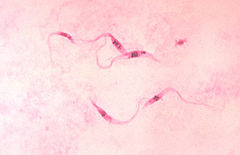- Kinetoplastid
-
Kinetoplastids 
Trypanosoma cruzi parasites Scientific classification Domain: Eukaryota Kingdom: Excavata Phylum: Euglenozoa Class: Kinetoplastida Orders Trypanosomatida
BodonidaThe kinetoplastids are a group of single-cell flagellate protozoa, including a number of parasites responsible for serious diseases in humans and other animals, as well as various forms found in soil and aquatic environments. They are members of the phylum Euglenozoa and their major distinguishing feature is the presence of a kinetoplast, a DNA-containing granule located within the single mitochondrion associated with the base of the cell's flagella (the basal body).
The kinetoplastids were first defined by Honigberg in 1961 as the flagellate order Kinetoplastida.[1] They are traditionally divided into the biflagellate Bodonidae and uniflagellate Trypanosomatidae; the former appears to be paraphyletic to the latter. One family of kinetoplastids, the trypanosomatids, is notable as it includes several genera which are exclusively parasitic. Bodo is a typical genus within kinetoplastida and including various common free-living species which feed on bacteria. Others include Cryptobia and the parasitic Leishmania.
Contents
Morphology
Kinetoplastids are eukaryotic and possess normal eukaryotic organelles, for example the nucleus, mitochondrion, golgi apparatus and flagellum. Along with these universal structures kinetoplastids have several distinguishing morphological features such as the kinetoplast, sub-pellicular microtubule array and the paraflagellar rod.
Kinetoplast
The kinetoplast, after which the class is named, contains the mitochondrial genome and is a dense DNA containing granule within the cell's single mitochondrion. The structure is made up of a network of concatenated circular DNA molecules and their associated structural proteins along with DNA and RNA polymerases. The kinetoplast is found at the base of a cell's flagella and is associated to the flagellum basal body by a cytoskeletal structure.
Cytoskeleton
The cytoskeleton of kinetoplastids is primarily made up of microtubules. These make a highly regular array, the sub-pellicular array, which run parallel just under the cell surface along the long axis of the cell. Other microtubules with more specialised roles, such as the rootlet microtubules, are also present. Kinetoplastids are capable of forming actin microfilaments but their role in the cytoskeleton is not clear. Other cytoskeletal structures include the specialised attachment between the flagellum and the kinetoplast.
Flagella
All kinetoplastids possess at least one flagellum, species in the order trypanosomatida have one and bodonina have two. In kinetoplastids with two flagella most forms have a leading and trailing flagellum, the latter of which may or may not be attached to the side of the cell. The flagella are used for locomotion and attachment to surfaces. The base of the flagella are found in a specialised pocket structure which is also the location of the cytostome.
Life cycle
Kinetoplastids may be free-living or parasitic. The order trypanosomatida is notable as it includes many genera which are exclusively parasitic. Trypanosomatids may have simple life cycles in a single host or more complex ones which progress through multiple differentiation stages in two hosts. Dramatic morphological changes are possible between lifecycle stages. Diseases caused by members of the order trypanosomatida include sleeping sickness and Chagas disease, caused by species of Trypanosoma, and leishmaniasis, caused by species of Leishmania.
References
- ^ Honigberg, B. M. (1963). "A contribution to systematics of the non-pigmented flagellates.". In Ludvík, J., Lom, J., Vávra, J. (eds.). Progress in Protozoology: proceedings of the first International Congress on protozoology held at Prague. Academic Press.
External links
Excavata Discoba Schizopyrenida: Vahlkampfiidae (Naegleria, Neovahlkampfia, Paravahlkampfia, Psalteriomonas, Sawyeria, Tetramitus/Paratetramitus, Vahlkampfia, Willaertia) · Gruberellidae (Stachyamoeba) · Rosculus
Acrasidae (Acrasis)
Heteramoeba · Learamoeba · Monopylocystis · StygamoebaPercolateaPercolomonas · StephanopogonAndaluciidaAndaluciaJakobidaJakobidae (Jakoba) · Histionidae (Reclinomonas, Histiona)M+M TrichozoaFornicataEopharingiaDiplomonadida: Hexamitinae (Spironucleus, Hexamita) · Giardiinae (Giardia, Octomitus)
Retortamonadida (Chilomastix, Retortamonas)OtherCarpediemonadida (Carpediemonas) · DysnectesAnaeromonadeaOtherCategories:- Flagellates
- Euglenozoa
Wikimedia Foundation. 2010.
